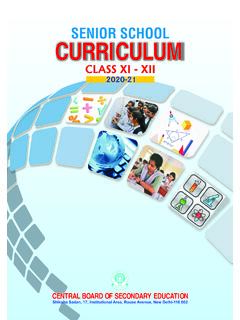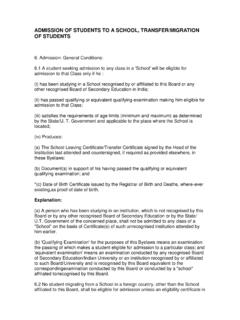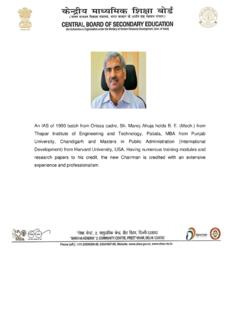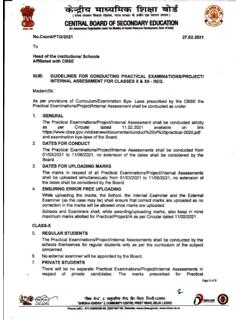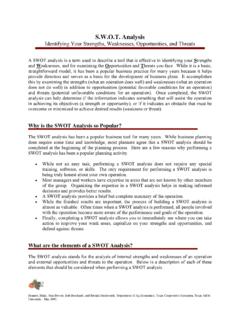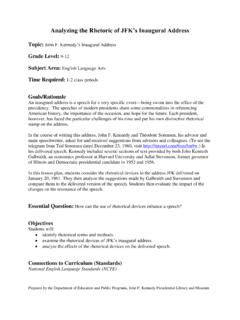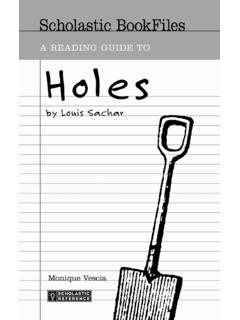Transcription of SECONDARY SCHOOL CURRICULUM - Central Board of …
1 SECONDARY SCHOOLCURRICULUMCLASS IX - XCENTRAL Board OF SECONDARY EDUCATIONCENTRAL Board OF SECONDARY EDUCATIONS hiksha Sadan, 17, Institutional Area, Rouse Avenue, New Delhi-110 0022020-211 OF THE CBSE CBSE CURRICULUM The CURRICULUM refers to the lessons and academic content to be taught to a learner in the SCHOOL . In empirical terms, it may be regarded as the sum total of a planned set of educational experiences provided to a learner by a SCHOOL . It encompasses general objectives of learning, courses of study, subject-wise instructional objectives and content, pedagogical practices and assessment guidelines. The CURRICULUM provided by CBSE is based on National CURRICULUM Framework-2005 and seeks to provide opportunities for students to achieve excellence in learning.
2 Salient Features of the CBSE SECONDARY SCHOOL CURRICULUM The CURRICULUM prescribed by CBSE strives to: ample scope for physical, intellectual and social development ofstudents; general and specific teaching and assessment objectives; Constitutional values such as Socialism, Secularism, Democracy,Republican Character, Justice, Liberty, Equality, Fraternity, Dignity ofIndividual and the Unity and integrity of the Nation by encouragingvalues-based learning activities; Life-Skills by prescribing curricular and co-curricular activities tohelp improve self-esteem, empathy towards others and different culturesetc.; innovations in pedagogy, knowledge and application, such ashuman sciences with technological innovations to keep pace with theglobal trends in various disciplines; inclusive education by providing equal opportunities to allstudents; environmental education in various disciplines from classes I-XII; emphasize Co-scholastic areas of Art Education and Health andPhysical Objectives of the CURRICULUM The CURRICULUM aims to: cognitive, affective and psychomotor excellence; self-awareness and explore innate potential; mastery over laid down competencies; 21st century learning, literacy and life skills; goal setting, and lifelong learning.
3 Values and foster cultural learning and internationalunderstanding in an interdependent society;2 the ability to utilize technology and information for thebetterment of humankind; knowledge and attitude related to livelihood skills; the ability to appreciate art and show case talents; physical fitness, health and arts integrated CURRICULUM Areas at SECONDARY Level CBSE envisions the all-round development of students in consonance with the holistic approach to education and therefore, emphasizes integration of co-curricular domain with curricular domain in an equitable manner. SECONDARY CURRICULUM provides students a broad and balanced understanding of subjects including languages, Mathematics, Science and Social Science to enable students to communicate effectively, analyse information, take informed decisions, construct their worldview in alignment with constitutional values and move ahead in the direction of becoming productive citizens.
4 The recent focus of CBSE is on the development of 21st century skills in settings where each student feels independent, safe and comfortable with their learning. The Board is also trying to align CURRICULUM in a way so that children feel more connected to it and employ their learning in real life contexts. To achieve this aim, it is extremely important that children acquire adequate knowledge and skills in other core areas like Health and Physical Education, Life Skills, Values Education, Art Education, Work Education and other Co-Scholastic areas. In operational sense, the SECONDARY CURRICULUM is learner-centered with SCHOOL being a place where students would be acquiring various skills; building self-concept, sense of enterprise, aesthetic sensibilities and sportsmanship.
5 Therefore, for the purpose of fostering core competencies in learners, this CURRICULUM encompasses major learning areas, from scholastic and co scholastic point of view. The Areas of learning at the SECONDARY level are as under: Languages 1 Compulsory Scholastic Areas Languages 2 Social Science Mathematics Science Other Academic Elective Subjects Optional Skill Elective 3 Subjects Health and Physical Education Work Experience* Art Education Subjects of internal Assessment Co-scholastic Areas * subsumed in Health and Physical Education Scholastic Areas :- The CURRICULUM envisages individualized learning acumen and seeks to explore the potential of students in acquiring substantial acknowledgement and skills through academic rigors.
6 With greater academic orientation and research skills in core academic areas, students would evolve as judicious young adults with a sense of real self-estimate having true values and principles. The scholastic areas are as follows: (i) Languages include Hindi, English and 37 other languages. The curricula in languages focus on listening, speaking, reading and writing skills and, hence, develop effective communicative proficiencies. Learners use language to comprehend, acquire and communicate ideas in an effective manner. (ii) Social Science (Geography, History, Economics and Political Science) intends to make learners understand their cultural, geographical and historical milieus and gain in-depth knowledge, attitude, skills and values necessary to bring about transformation for a better world.
7 Social Science includes the learning of history and culture, geographical environment, global institutions, constitutional values and norms, politics, economy, interpersonal and societal interactions, civic responsibilities and the incorporation of the above-mentioned learning. Learners appreciate and value everyone s right to feel respected and safe, and, also understand their Fundamental Rights and Duties and behave responsibly in the society. (iii) Science (Biology, Chemistry and Physics) includes gaining knowledge about Food, Materials, The World of the Living, How things work, Moving things, People and Ideas, Natural Phenomenon and Natural Resources.
8 The focus is on knowledge and skills to develop a scientific attitude and to use and apply such knowledge for improving the quality of life. This learning can be used to analyze, evaluate, synthesize and create. Learners understand and appreciate the physical, biological and technological world and acquire the knowledge and develop attitude, skills and values to make rational decisions in relation to it. (iv) Mathematics includes acquiring the concepts related to number sense, operation sense, computation, measurement, geometry, probability and statistics, the skill to calculate and organize, the ability to apply this 4 (v) knowledge and acquired skills in their daily life and the skills to think mathematically.
9 It also includes understanding of the principles of reasoning and problem solving. Children learn to rationalize and reason about pre-defined arrangements, norms and relationships in order to comprehend, decode, validate and develop relevant patterns. (vi) A well-skilled workforce is one of the main supports for prosperity and growth for any country. Some skills come from general education, but specific occupational skills are also important. Typically initial vocational education and training systems have a big part to play in supplying these skills. To develop skills and talents as a form of free expression, Board offers variety of competency based subjects under NSQF like Retail, Information Technology, Marketing & Sales, Banking, Finance, AI etc.
10 Choosing any one Skill subject at SECONDARY level can helps the child to pursue what truly interests or pleases him or her. This liberty promotes a sense of self-esteem in accepting one s own talents and strengths. The CURRICULUM and the study material for the Skill Electives is available on the CBSE academic website under the tab Skill Education and can be accessed through the link: html. Co- Scholastic Areas:- Only a healthy child can learn effectively and good health leads to better learning. Many activities are necessary for development of the affective and psychomotor domain. The activities like games and sport, art and music, craft work etc.

